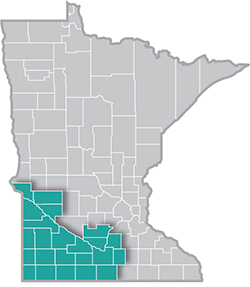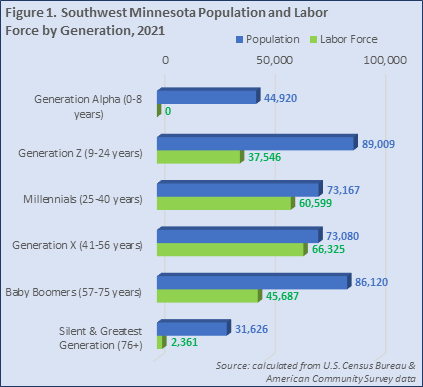 Southwest Minnesota is a national leader in agricultural production, and renewable energy.
Southwest Minnesota is a national leader in agricultural production, and renewable energy.
The region's thriving manufacturing sector includes food processing, machinery, printing, metal products, and computers and electronic products.
Want the freshest data delivered by email? Subscribe to our regional newsletters.
3/20/2023 9:00:00 AM
Luke Greiner, Amanda O'Connell
Home to just under 400,000 people, there are now seven generations living together in the 23 counties of Southwest Minnesota. After decades of domination, the Baby Boomers have been surpassed by Generation Z as the largest cohort, with just over 89,000 people, compared to 86,000 Baby Boomers. Millennials and Generation X both have about 73,000 people. The youngest age group, now titled Generation Alpha, is closing in on 45,000 people, while the two oldest generations – Silent and Greatest – now have just over 31,500 people (Figure 1).
 Consequently, there are now five generations at work in Southwest Minnesota, ranging from teenagers in Generation Z to senior citizens in the Silent Generation. According to estimates from the U.S. Census Bureau's American Community Survey, Generation X makes up the largest cohort in the region's labor force, accounting for about 66,325 workers, followed by Millennials with just over 60,500 workers. As the front end of the Baby Boom generation has started reaching retirement age, the number of Baby Boomers has dropped to just under 46,000 workers, and there are still about 2,350 workers aged 76 years and older in Southwest Minnesota. Generation Z is the most recent generation that has entered the workforce and provides more than 37,500 workers from 16 to 24 years of age.
Consequently, there are now five generations at work in Southwest Minnesota, ranging from teenagers in Generation Z to senior citizens in the Silent Generation. According to estimates from the U.S. Census Bureau's American Community Survey, Generation X makes up the largest cohort in the region's labor force, accounting for about 66,325 workers, followed by Millennials with just over 60,500 workers. As the front end of the Baby Boom generation has started reaching retirement age, the number of Baby Boomers has dropped to just under 46,000 workers, and there are still about 2,350 workers aged 76 years and older in Southwest Minnesota. Generation Z is the most recent generation that has entered the workforce and provides more than 37,500 workers from 16 to 24 years of age.
In the past, Southwest Minnesota's labor pool deepened with a steady stream of new workers. This was due to several factors including population growth and in-migration, high and rising labor force participation rates for females, and a stable flow of high school seniors graduating into the workforce. All of these are important sources of labor force growth. However, data shows that the region's labor force suffered a significant decline of nearly 11,000 workers in 2020 and 2021 in the aftermath of the Pandemic Recession, creating new challenges for employers to find workers for open jobs.
Moving forward, labor force projections show the region may experience another 11,000 worker decline over the next decade, based on population projections from the Minnesota State Demographic Center and current labor force participation rates. Aside from an overall decrease, the age structure of the labor force is also projected to shift over the next 10 years, with large declines in the number of workers aged 55 to 64 years as the back end of the Baby Boom generation reaches retirement age. The region is expected to see gains in the number of 45 to 54-year-olds as Millennials enter their prime working years, but that will be more than offset by losses as the front end of Generation X passes 60 years of age and starts dropping out of the labor force. The region is also expected to see some gains in the entry level workforce from Generation Z and the front end of Generation Alpha, as well as an increase of older workers as Baby Boomers stay active longer (see Table 1).
| Table 1. Southwest Minnesota Labor Force Projections, 2023-2033 | ||
|---|---|---|
| - | 2023-2033 Projected Change | |
| Numeric | Percent | |
| 16 to 19 years | -553 | -4.5% |
| 20 to 24 years | +379 | +1.5% |
| 25 to 44 years | -3,930 | -4.9% |
| 45 to 54 years | +2,925 | +8.4% |
| 55 to 64 years | -8,209 | -23.3% |
| 65 to 74 years | -1,730 | -12.6% |
| 75 years & over | +590 | +20.6% |
| Total Labor Force | -10,529 | -5.2% |
| Source: calculated from Minnesota State Demographic Center population projections and 2017-2021 American Community Survey 5-Year Estimates | ||
In step with workforce declines, the shifting age structure will lead to a tighter labor market in the future, with employers needing to respond to changing labor force availability. If the region's demographics don't change, labor force growth will have to come from other sources, such as immigration or tapping into underserved populations such as workers of color, workers with disabilities, or justice system-involved people to help increase labor force participation rates.
Contact Luke Greiner at luke.greiner@state.mn.us or Amanda O'Connell at amanda.oconnell@state.mn.us.